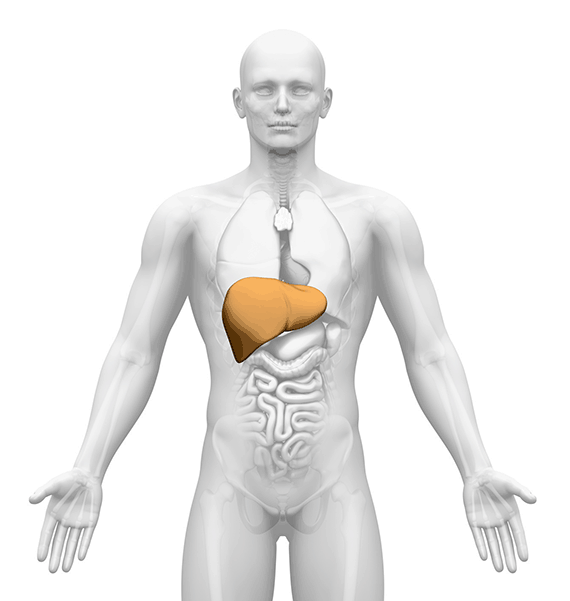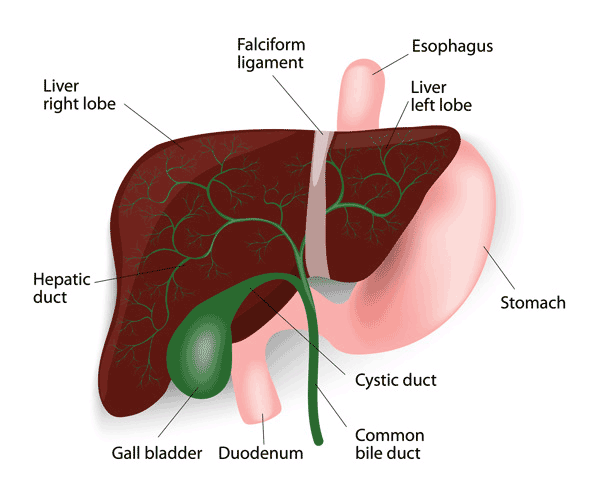The Liver is the largest and an important internal organ located in the upper right portion of the abdomen. It is protected by the ribcage. The liver is the most complex organ that performs over 500 vitally necessary tasks and functions. The liver processes everything we eat, drink, inhale or absorb through our skin.
A healthy liver has soft and spongy texture and is pinkish to reddish brown in color.


Liver disease has become the 12th most common cause of death in the U.S. Over 100 million Americans have some form of liver disease, yet many of them are unaware of this. It is also the 4th leading cause of death for people between 45 to 54 years of age.
Due to the progression and spread of liver disease, medical costs for patients with HCV are expected to rise to over $85 billion by the year 2024.
Relatively little is known to the public about the causes, symptoms and prevention of liver disease. As a result, the number of newly diagnosed cases is on the rise as never before.
The tricky part is that the symptoms of an inflamed liver are not always displayed in its early stages. One might confuse the first signs of certain types of liver disease (such as physical exhaustion) with the common flu. Going to regular medical check-ups can help you get a proper diagnosis.
Some of the common types of liver disease include:
Hepatitis A is an acute infectious disease that occurs most commonly in countries with low hygiene standards. It is considered to be one of the most typical travel-related diseases. Hepatitis A is usually spread by eating or drinking food or water contaminated with infected feces. Shellfish which have not been sufficiently cooked are a relatively common source. Hepatitis A may also be spread through close contact with an infectious person. The symptoms can include fatigue, fever, and loss of appetite that appears 10-15 days after it’s been contracted. In most cases the infection can be cured without any secondary health damages. In rare cases, especially in older patients, the disease can be fatal.
There are no special medications for the treatment of hepatitis A. Patients are normally prescribed bed rest. Before travelling to the tropics, doctors strictly recommend that their patients be vaccinated.
A disease with a similar progression is hepatitis E which can be transmitted through contaminated food or water. Again, this is very common in countries with limited access to general sanitation, hygiene and clean water.
Hepatitis B can be transmitted through sexual intercourse and through contact with blood. An infected mother can pass the virus onto their newborn babies. The symptoms may appear over six months after contamination.
There is a vaccine available to prevent hepatitis B. Physicians recommend that all infants from the ages of two months, small children, and adolescents up to the age of 18 years who have not been vaccinated yet, should get vaccinated.
Hepatitis D can occur accompanying hepatitis B, which aggravates the progression of the disease. In this case, the risk of liver cirrhosis and liver cancer increases.
Hepatitis C is usually transmitted through the blood. People injecting drugs and sharing the devices with others are most vulnerable. According to the World Health Organization (WHO), three to four million people worldwide get newly infected with hepatitis C every year. It is estimated that the number of chronically infected people are between 130-150 million people.
There are no vaccines against hepatitis C. The use of combination therapies with antiviral medications can help to achieve the cure rate by 90-100%.
The development of liver conditions in the U.S. is a direct reflection of specific lifestyle choices and nutritional habits. Although liver conditions are stereotypically associated with alcohol or drugs, there are over 100 known forms of liver conditions caused by various factors exposing adults as well as infants.
However, the exact origin of many liver diseases is often unknown. The most prevalent liver conditions are caused by:

Being well aware of symptoms and potential risk factors can help identify the disease in time and increase chances of survival. In addition, over the last years, the chances for successfully treating liver disease have improved due to newly-developed medications and therapies.
The symptoms of liver disease can arise suddenly (acute symptoms) or systematically (chronic symptoms).
Though the symptoms may vary depending on condition, but the most common signs of developing liver disease can include:
Sources:
¹ Flegal KM, Carroll MD, Kit BK, Ogden CL. Prevelance and trends in the distribution of body mass index among US adults, 1999-2010. Journal of the American Medical Association. 2012; 307(5):491-97.
² Yoon, Y.H., and Yi, H.Y. Surveillance Report #93: Liver Cirrhosis Mortality in the United States, 1970–2009. Bethesda, MD: NIAAA, 2012.
³ Singal, A.K.; Guturu, P.; and Hmoud, B.; et al. Evolving frequency and outcomes of liver transplantation based on etiology of liver disease. Transplantation 95(5):755–760, 2012.
⁴ Crabb DW. Pathogenesis of alcoholic liver disease: newer mechanisms of injury. Keio J Med 1999;48:184-188.
https://www.cdc.gov/media/releases/2016/p0504-hepc-mortality.html
Your lifestyle directly affects your health. The food and water you consume, your environmental conditions, your daily activities and habits can benefit or harm your liver.
When it comes to your liver health, we would like to help you make the right choices and give you some advice on how to prevent liver diseases:
Since the liver is an important regulator of metabolism, storage, and nutrition, the liver directly reacts to food you consume. Regular consumption of unhealthy food and poor nutrition can cause various liver diseases. For example, fatty liver disease, one of the most common types of liver conditions, is usually associated with obesity, diabetes, and sedentary lifestyle. Find out more about a healthy liver diet here.
When you drink alcohol, your liver is responsible for detoxifying your blood. Alcohol-overload can affect not only your liver, but your brain and heart. Regular alcohol consumption can damage and destroy your liver cells. As a result, this can lead to serious liver diseases. For example, fatty liver can develop in 90% of people who drink more than 60 g of alcohol per day. Over 40% of all cirrhosis deaths in 2009 were caused by high alcohol consumption.
Always take your medications correctly – avoid overdose and non-prescribed medication. Do not forget that any medication you take will be processed by the liver, and when combined with other medication or alcohol, it can be toxic. It is always worth talking to your physician instead of putting yourself at risk through self-diagnosis.
Regular physical activities will definitely benefit your liver. Exercise will help you enhance your immune and cardiovascular systems and generally improve your quality of life through maintaining a healthy weight. In addition, obesity contributes to a higher risk of developing fatty liver disease.
Certain liver diseases such as Hepatitis A, B, and C can be transmitted sexually. When being involved in sexual activity, it is important to remember to protect yourself to help both you and your partner avoid any possible risks.
You should not forget about your liver health when you are planning to travel. Travel vaccinations will protect you from various infectious diseases that can be found overseas. Find out before your trip about the possible health risks and whether you have to get vaccinated. While traveling, always make sure that the water and food you consume are safe. Avoid exposure to toxins.
Toxic substances, accumulating in the liver, can negatively affect the liver health and lead to the damage of its cells. That is why you should always wear gloves, long sleeves or a mask to avoid direct contact with toxins from chemicals, cleaning products, or insecticides.
Back to top